With the development of artificial intelligence and machine learning, the media and entertainment sector has undergone a tremendous transformation. Vast content libraries available through streaming services have replaced generic broadcast television and rigid programming schedules. The easy accessibility and high-quality on-demand video, music, and gaming have revolutionised how audiences consume content, increasing demand for tailored experiences that cater to their unique tastes.
AI based personalisation has become the cornerstone of streaming success. Companies such as Netflix, Spotify, Amazon Prime Video, and Disney+ now have the ability to analyse viewing patterns, genres, and user feedback to deliver personalised content recommendations and help audiences discover new and engaging titles. To optimise their personalisation strategies, streaming platforms are increasingly turning to AI app development services for expert guidance. This customisation level enhances user satisfaction, creates a sense of exclusivity and relevance, and encourages long-term loyalty. The more personalised the experience, the more likely viewers are to discover new content that resonates with their preferences. And this leads to increased consumption and higher user retention rates.

The Benefits Of AI-Based Personalisation
AI based personalisation, therefore, not only means more exciting and engaging content for users. It also helps brands gain a larger share in the streaming market, which is projected to reach a revenue of $107 million by 2023 and exceed $172.20 million by 2027.
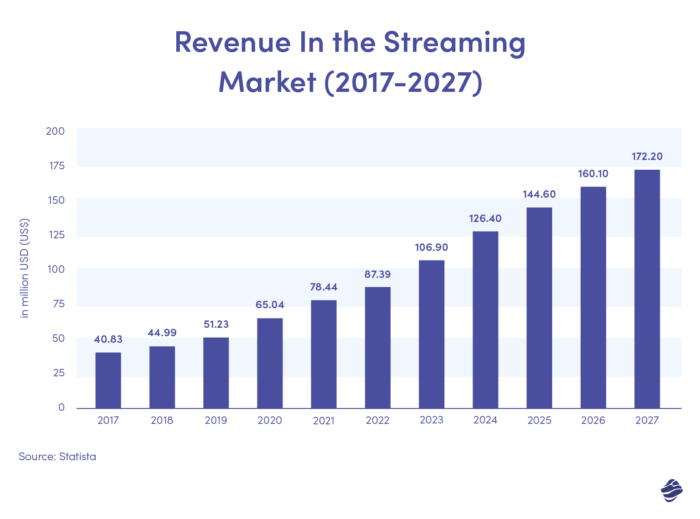
What AI and machine learning technologies lie at the heart of personalised streaming services? How do AI algorithms collect and analyse user data to deliver content recommendations? Let’s discuss the fundamental principles, benefits and applications of AI based personalisation for the streaming industry, including user profiling and preference analysis, content recommendation systems, and enhancing user engagement and retention.
Business Perks of AI Based Personalisation
Businesses can leverage AI algorithms to gain deeper insights into customer preferences, behaviours, and needs. By analysing vast amounts of data, AI can identify patterns and trends humans may miss, allowing businesses to deliver highly tailored experiences. This personalised approach enhances user experience and marketing effectiveness, improves conversion rates and customer retention, and enables unprecedented scalability.
The key advantages of AI based personalisation include:
- Enhanced user experience: By analysing user data, preferences, and behaviour, AI algorithms can provide personalised recommendations, content, and interactions, resulting in a more engaging and relevant user experience.
- Increased conversion rates: AI can significantly increase conversion rates and drive sales by presenting users with personalised offers, product recommendations, or relevant content at the right moment.
- Greater customer retention: When users receive personalised experiences that align with their preferences and needs, they are more likely to remain engaged with a brand or platform over time.
- Marketing effectiveness: AI makes it easier for marketers to segment audiences, create personalised messaging, and deliver campaigns at the right time and through the most effective channels, resulting in higher marketing effectiveness and better ROI.
- Scalability: With AI algorithms handling the personalisation process, businesses can efficiently deliver personalised experiences to many users, ensuring scalability without compromising quality.
AI based personalisation enables businesses to optimise resource allocation, ensuring that marketing efforts, customer service, and product recommendations are directed where they are most likely to yield positive outcomes. To capitalise on the potential of AI-driven personalisation, businesses can partner with specialised entertainment app development services that integrate AI technologies into their platforms. This not only improves operational efficiency but also maximises the return on investment.
Examples Of AI Based Personalisation In The Streaming Industry
In streaming platforms, AI algorithms analyse vast amounts of user information, including viewing history, preferences, ratings, and interactions. By leveraging machine learning techniques, systems learn from patterns and trends within the data, allowing them to make intelligent predictions and recommendations and deliver customised experiences.
Furthermore, AI techniques, such as natural language processing (NLP), enable the understanding of user sentiments and interests from textual data, i.e., user ratings and reviews. Predictive analytics, in turn, helps forecast user behaviour, allowing for targeted marketing campaigns and optimised user experiences.
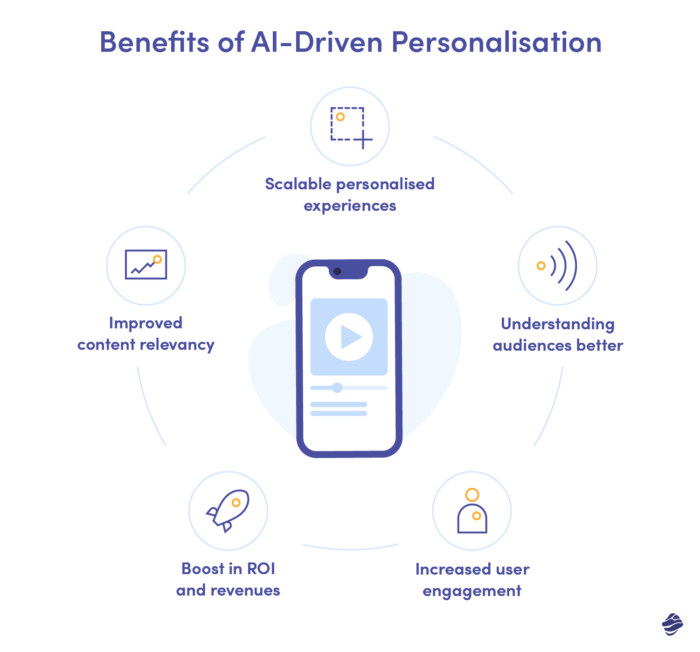
Both AI and ML play a vital role in personalising streaming platforms by leveraging data-driven insights to tailor interactions, content, and recommendations. Let’s discuss specific examples of tools and techniques supported by real-world applications from leading streaming services.
AI Based Recommendation Systems
In the era of streaming platforms, the sheer volume of available music, TV shows and movies can overwhelm users. Hence, AI-based recommendation systems have emerged as powerful tools to help users navigate through vast libraries and discover content tailored to their preferences.
AI-based recommendation systems analyse user data, such as viewing history, ratings, and interactions, to generate personalised recommendations. By understanding user preferences and behaviour patterns, recommendation systems enhance user engagement and increase content consumption.
Types of AI Based Recommendation Systems
Our article comprehensively discussed the business benefits, types, and applications of recommendation systems. Therefore, we will only briefly summarise the most crucial information. There are four main types of recommendation systems:
- Popularity-based filtering
The easiest type of recommendation system is based on item popularity and can be implemented using explicit or implicit data:
- Using explicit data: suggesting popular movies based on the average of the user 5-star ratings,
- Using implicit data: suggesting popular movies based on the number of times users played them.
One of the notable advantages of popularity-based recommendation systems is their resistance to the user cold-start problem, as they can provide recommendations without any prior information about the user. Additionally, these systems can be effective in environments with a small number of users.
- Content-based filtering
Content-based filtering focuses on the characteristics and attributes of the items themselves. It analyses the properties of the recommended items, such as genres, actors, or keywords, and compares them to the user’s preferences and past behaviour. By creating a profile for each user and item, content-based filtering recommends items similar to the ones the user has previously enjoyed. This approach is useful when ample information about the items is available, allowing for accurate recommendations based on item features.
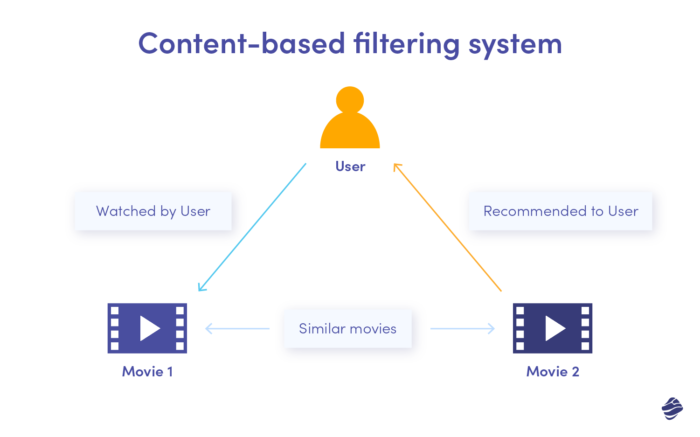
- Collaborative filtering
Collaborative filtering focuses on the behaviour and preferences of similar users. It identifies patterns among users with similar tastes and preferences, suggesting items other like-minded users have enjoyed. Collaborative filtering does not rely on explicit item attributes but on the collective wisdom of users’ interactions and feedback. This approach is particularly useful in scenarios with limited item information available or when personalisation based on user similarities is a priority.
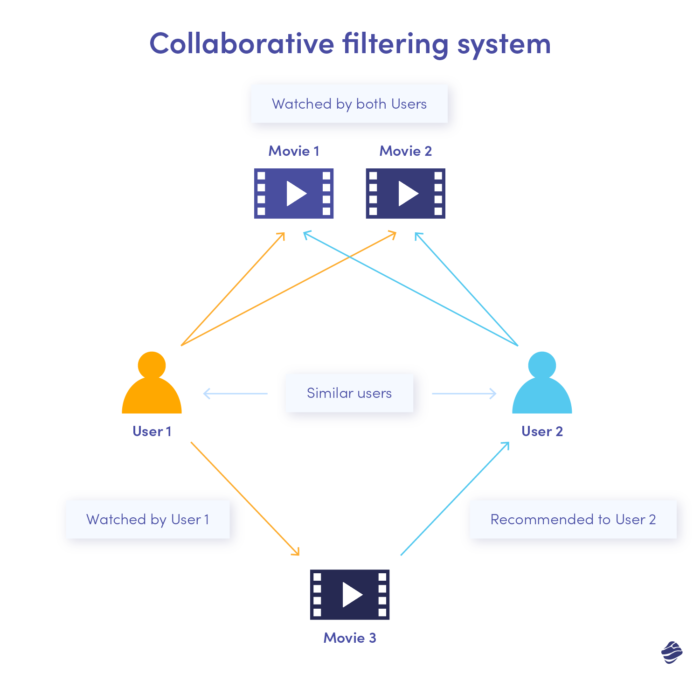
- Hybrid filtering
Hybrid recommendation systems combine content-based and collaborative methods. This solution can be more effective in practice than any of the two methods separately. Hence, it is no wonder why Hybrid systems are used on Netflix, where the movie recommendations result from comparing the watching habits of similar users (collaborative filtering) and finding movies with similar characteristics like films that users have liked in the past (content-based filtering).
Applications of AI Based Recommendation Systems in Streaming Platforms
According to McKinsey, a staggering 75% of what users watch on Netflix is attributed to movie recommendations. In a paper titled “The Netflix Recommender System: Algorithms, Business Value, and Innovation,” by Netflix executives, it is revealed that the recommendation system saves the company approximately $1 billion annually. Furthermore, Spotify reported that the implementation of a new recommendation algorithm played a significant role in increasing their monthly user base from 75 million to 100 million.
AI-based recommendation systems have become integral to the success of well-known streaming platforms like Netflix, Spotify, and YouTube. Let’s explore the types of recommendation systems utilised by these companies and their business impact.
- Netflix
Netflix’s recommendation system analyses user viewing history, ratings, and interactions and uses collected data to generate personalised content suggestions. The platform leverages a hybrid approach that combines collaborative filtering and content-based filtering techniques. This ensures that users receive recommendations based on their unique preferences and introduces them to new and relevant content.
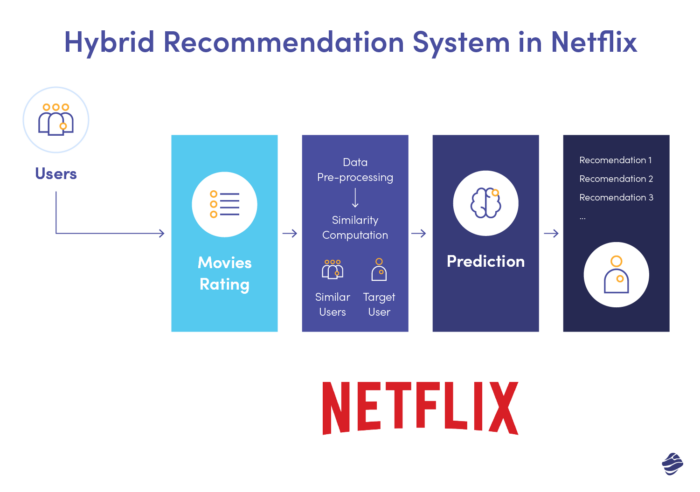
- Spotify
Spotify employs a hybrid recommendation system that analyses user listening history, behaviour, and preferences to create personalised playlists and suggest new songs, albums, and artists. By leveraging machine learning algorithms, Spotify identifies patterns and similarities among users with similar tastes, providing tailored recommendations that align with individual preferences. This personalised approach enhances the user experience and keeps users engaged and connected to the platform.

- YouTube
YouTube utilises AI-powered recommendation engines to enhance user engagement and personalised content discovery. By analysing user behaviour, viewing history, and interactions, YouTube’s recommendation system suggests videos that align with a user’s interests. The platform employs algorithms that consider factors like video popularity, user engagement, and content relevance to provide tailored recommendations.
Recommendations drive a significant amount of the overall viewership on YouTube, even more than channel subscriptions or search.
Cristos Goodrow VP of Engineering At YouTube
AI Driven User Profiling and Preference Analysis In Streaming Platforms
User profiling and preference analysis are AI-based tools that make gaining insights into user behaviour and interactions easier, thereby enhancing the content discovery experience. Analytics teams in streaming platforms utilise AI-driven user profiling and preference analysis to:
- Provide personalised content recommendations,
- Increase user satisfaction,
- Foster business growth,
- Increase revenues.
User Profiling and Preference Analysis Step By Step
AI-driven user profiling and preference analysis in streaming platforms is a process that consists of several steps:
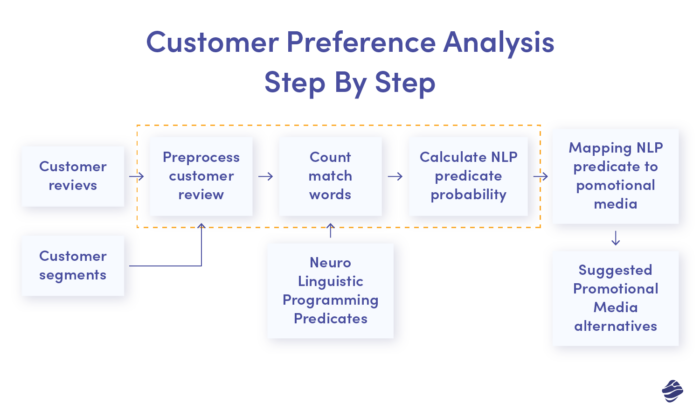
- Step 1: Data Collection
Streaming platforms collect user data through various means, such as user opt-in data sharing, cookies, device tracking, and user account information. This data includes user behaviour, such as viewing history, search queries, interactions with content (pausing, rewinding, skipping), ratings, reviews, explicit feedback, and contextual data like time of day, location, and device used. Last but not least, streaming platforms ensure compliance with data protection regulations while safeguarding user privacy.
- Step 2: Data Storage, Management and Preprocessing
Data collected from streaming platforms’ users is stored securely in databases or data storage systems to ensure data integrity, security, and privacy. Before analysis, the collected data undergoes preprocessing, i.e. cleaning and transforming the data, removing duplicates, handling missing values, and normalising or standardising data formats.
- Step 3: User Profiling
User profiles are created based on the collected and preprocessed data, with the machine learning techniques like clustering and classification. These profiles group users with similar preferences and behaviour patterns together, allowing platforms to understand the unique tastes of each user, e.g. preferred genres, actors, directors, past interactions, and viewing habits.
- Step 4: Preference Analysis and Modeling
AI algorithms analyse user profiles to identify patterns, correlations, and similarities among users. These insights help create preference models that can accurately predict user preferences and behaviour. Machine learning models, such as collaborative filtering, content-based filtering, or hybrid approaches, are employed to generate accurate predictions and recommendations.
- Step 6: Personalised Recommendations
Personalised content recommendations are generated based on preference models and user profiles. The algorithms consider factors like user history, ratings, explicit and implicit feedback, and contextual information to provide tailored suggestions.
- Step 7: Continuous Learning and Improvement
AI-driven user profiling and preference analysis are iterative processes. The algorithms continuously learn and adapt as users interact with the platform and provide feedback. The data collected from user interactions, ratings, and feedback is later used to refine the models and improve the accuracy of recommendations over time.
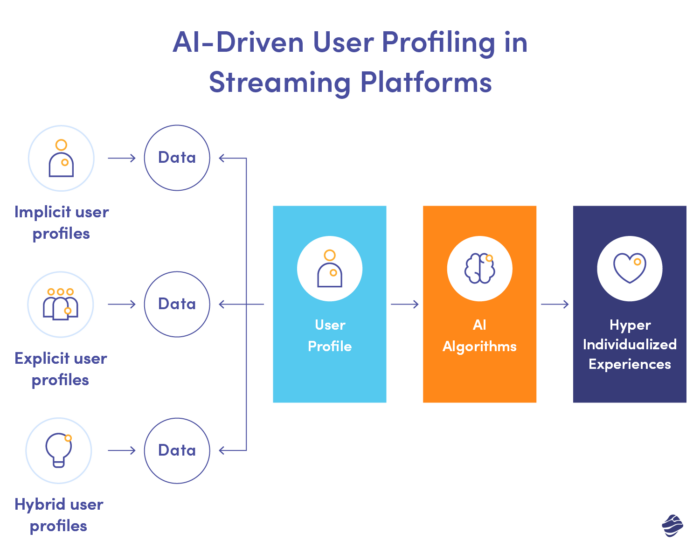
Applications of User Profiling and Preference Analysis in Streaming Platforms
Several well-known brands in the streaming industry employ user profiling and preference analysis techniques to enhance their platforms. The most notable examples include:
- Disney+
Disney+, the popular streaming platform by The Walt Disney Company, utilises AI-driven user profiling and preference analysis to enhance the content discovery experience. Through user data collection, including viewing history, ratings, and interactions, Disney+ creates detailed user profiles. Their AI algorithms leverage this data to generate accurate predictions and recommendations, tailoring the content to individual users.
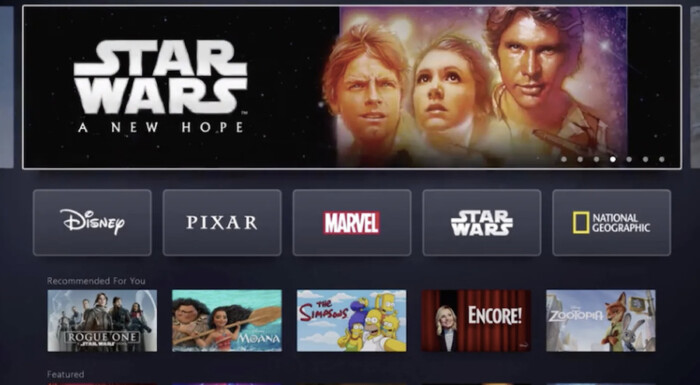
- HBO Max
HBO Max, the streaming service owned by WarnerMedia, also relies on AI-driven user profiling and preference analysis. By collecting and analysing user data such as viewing behaviour, engagement patterns, and explicit feedback, HBO Max builds user profiles to understand individual preferences. With this data, HBO Max’s AI algorithms generate personalised recommendations, suggesting movies, TV shows, documentaries, and exclusive content from their extensive library. This personalised approach enhances the user experience, enabling viewers to discover and enjoy content that resonates with their unique tastes.
- Apple TV+
Apple TV+ applies user profiling and preference analysis techniques to recommend personalised content. By collecting and analysing user data, including viewing behaviour, ratings, and interactions, Apple TV+ creates user profiles that enable tailored suggestions so subscribers can access a curated collection of original series, films, and documentaries that match their preferences.
The future of AI Based Personalisation in Streaming Platforms
The benefits of AI-driven personalisation extend to both streaming platforms and users. Platforms can enjoy higher user engagement, increased subscription rates, and improved revenue streams. Users, on the other hand, benefit from a more streamlined and customised content discovery process, saving them time and effort. They can explore a vast library of content curated to match their interests. And hence, make their streaming experience more enjoyable and personalised.
Looking into the future, AI-based personalisation is expected to undergo even more remarkable transformations. As AI systems become more advanced, they have a better understanding of user context. Factors such as mood, location, social dynamics, and even physiological states may influence content recommendations. Additionally, the integration of augmented and virtual reality technologies will provide users with immersive and personalised experiences.

Responsible AI Implementation in Streaming Platforms
Last, but not least, it is essential to emphasise the importance of responsible AI implementation. While AI based personalisation offers numerous advantages, it also raises concerns about data privacy, algorithmic biases, and ethical considerations. Therefore, streaming platforms must prioritise user privacy, transparency, and ethical data usage.
To ensure responsible AI implementation, streaming platforms can adopt various practices, including investing in ongoing research and development of data privacy, collaborations with academic institutions and non-profit cybersecurity groups, regular audits and third-party certifications.
AI-Driven Revolution In Streaming Industry
AI based personalisation is revolutionising the streaming industry. With natural language processing, sentiment analysis, and deep learning advancements, streaming platforms can provide personalised experiences. This transformative approach benefits streaming platforms and users, increasing engagement, loyalty, and overall satisfaction. Hence, it is safe to state that the future of AI based personalisation holds great promise. And will surely continue to shape how we consume and enjoy streaming content.









